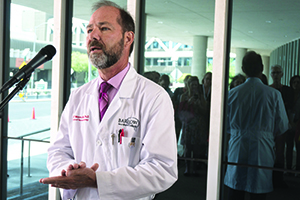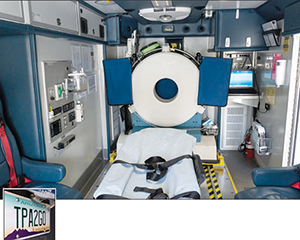By JUDITH VANDEWATER
PHOENIX — When it comes to acute stroke management, time is brain. Neurologists refer to the "golden hour" of therapeutic opportunity between the time a patient suffering an ischemic stroke arrives at the emergency room to the time treatment with a clot-busting drug commences.

Dr. Michael F. Waters, director of the neurovascular division at Barrow Neurological Institute, tells journalists about a mobile stroke unit commissioned by the institute in October. Staff can start aggressive drug therapy in the field, potentially reducing long-term disability. The institute is part of Dignity Health St. Joseph's Hospital and Medical Center.
Photo by Daria Kadovik/Cronkite News
The American Stroke Association and the Joint Commission would like hospitals to achieve a "door-to-needle time" of 45 minutes or less in 50 percent of stroke patients. According to research published online in the August 2017 issue of Stroke, the journal of the American Heart Association, about 50 percent of patients receive an antithrombotic drug within 60 minutes or less of their hospital arrival.
Damage to brain tissue associated with long-term disability in stroke survivors begins with the onset of an ischemic stroke, so the time that elapses in reaching and transporting a patient to the hospital can be a critical factor in patient outcome too. Dr. Michael F. Waters, a vascular neurologist who directs the neurovascular division at Barrow Neurological Institute at Dignity Health St. Joseph's Hospital and Medical Center here, calls this "dispatch-to-needle time."
With the launch of the Barrow Emergency Stroke Treatment Unit in October, Barrow became one of the first dozen-plus hospitals in the world to significantly cut therapeutic response time in ischemic stroke with a mobile response unit, he says. The units allow clinicians to initiate treatment with intravenous tissue plasminogen activator, the clot-busting drug known as TPA, in the field.
"This represents a vanguard in stroke care," Waters tells a group of about 30 journalists touring the institute in late April in conjunction with the annual meeting of the Association of Health Care Journalists. "Sooner is always better" with stroke interventions, he says.
The stroke unit was out on an emergency call when Waters met with the journalists, as it has been on 300 occasions since it was commissioned. (About one-third of those calls were for patients diagnosed with stroke.) On this day, the unit returned after about an hour and the group got a look at the portable CT scan and angiogram, and audiovisual telemedicine communications system that make it possible to safely administer TPA in the field.
The drug is a high-risk, high-reward therapy that has the potential to limit disability and recovery time when used appropriately. It can cause harm or even death if it is administered to a patient with bleeding in the brain or other contraindications. Research shows that when administered in appropriate cases, the drug improves outcomes in about half of patients with ischemic stroke.

Staffed by a registered nurse and a CT technician, the mobile stroke unit has a small lab and a CT scanner that transmits images to the Barrow Neurological Institute, where a specialist makes a diagnosis and directs emergency treatment. The van's vanity license plate is at left. Photo by Daria Kadovik/Cronkite News
Before a patient is given the intravenous drug in the mobile stroke unit, multiple triages have occurred. A 911 dispatcher asks questions to determine the possibility of a stroke before dispatching a Phoenix Fire Department ambulance and the Barrow stroke unit.
Phoenix fire department paramedics — the first responders on the scene — give emergency aid and evaluate the patient for signs of ischemic stroke. The Barrow stroke unit, which is staffed by a registered nurse and CT technician, responds to calls when it can arrive on the scene within 20 minutes. Although Waters calls it "an emergency room on wheels," the unit is technically not an ambulance. It does not use sirens or flashing lights; it follows speed limits and traffic regulations.
When the stroke unit arrives, the patient is transferred to its bay for an examination by the nurse and scans by the CT technician. Waters or another attending neurologist are connected to the unit via a telemedicine link and can converse with the patient and clinicians and do a close-up exam, even looking into the patient's pupils.
The physician views the brain scans, and reviews the patient's medical record, if available, along with any information about the patient's condition and onset of stroke symptoms before giving an order to administer TPA and vetting the patient for other interventions. Once the drug drip is started, patient and nurse board the ambulance for the lights and sirens trip to the nearest hospital where a stroke team is waiting.
When the diagnosis is a hemorrhagic stroke, Waters can direct the nurse to administer drugs that can aggressively reduce blood pressure or reverse the blood thinning properties of anticoagulant medications including heparin or warfarin.
"We went into this thinking we were going to improve outcomes for ischemic stroke," he says. "Hemorrhagic stroke wasn't even on my radar, except to exclude those patients from TPA therapy." But the potential exists to improve patient outcomes for those patients as well, he says.
Some of the mobile stroke units in other markets have a physician as part of the onboard response team. Waters says data likely will be available next year to allow researchers to compare patient outcomes between that model and the telemedicine physician coverage model used in Phoenix.
The Barrow mobile stroke unit cost about $1 million fully outfitted with CT scan and other equipment, Waters says. The unit was funded by philanthropy, including gifts from the Thunderbirds Charities, and the Board of Visitors, a women's charitable organization. He estimates that labor costs will add another $1 million annually to the unit's operating budget.
"People recognize the potential for this type of program" for reducing long-term disabilities caused by stroke. "It is not a hard sell," he says.
Copyright © 2018 by the Catholic Health Association
of the United States
For reprint permission, contact Betty Crosby or call (314) 253-3490.